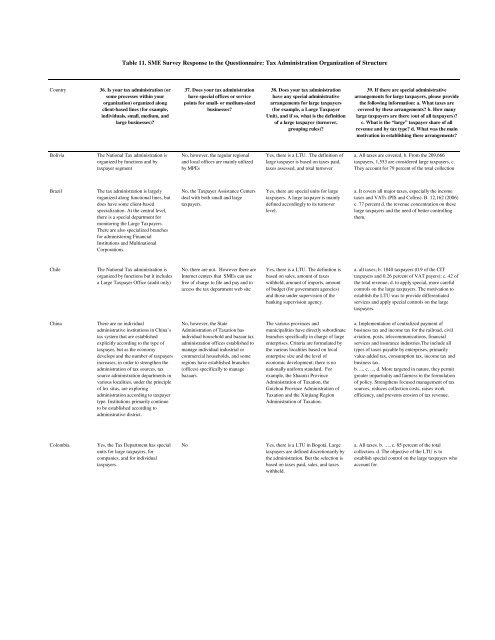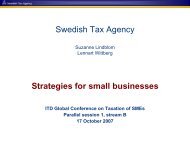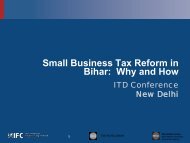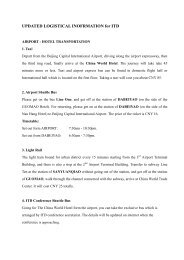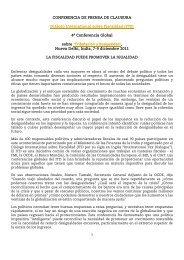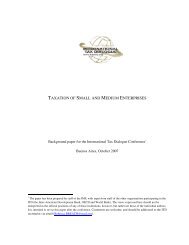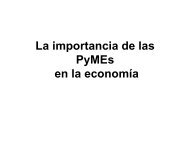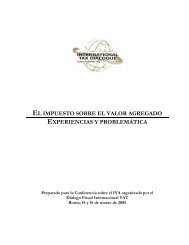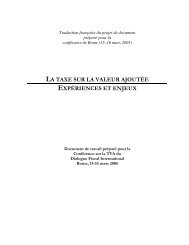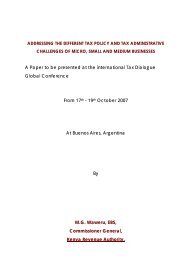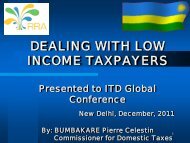PDF format - International Tax Dialogue
PDF format - International Tax Dialogue
PDF format - International Tax Dialogue
Create successful ePaper yourself
Turn your PDF publications into a flip-book with our unique Google optimized e-Paper software.
Table 11. SME Survey Response to the Questionnaire: <strong>Tax</strong> Administration Organization of Structure<br />
Country<br />
36. Is your tax administration (or<br />
some processes within your<br />
organization) organized along<br />
client-based lines (for example,<br />
individuals, small, medium, and<br />
large businesses)?<br />
37. Does your tax administration<br />
have special offices or service<br />
points for small- or medium-sized<br />
businesses?<br />
38. Does your tax administration<br />
have any special administrative<br />
arrangements for large taxpayers<br />
(for example, a Large <strong>Tax</strong>payer<br />
Unit), and if so, what is the definition<br />
of a large taxpayer (turnover,<br />
grouping rules)?<br />
39. If there are special administrative<br />
arrangements for large taxpayers, please provide<br />
the following in<strong>format</strong>ion: a. What taxes are<br />
covered by these arrangements? b. How many<br />
large taxpayers are there (out of all taxpayers)?<br />
c. What is the “large” taxpayer share of all<br />
revenue and by tax type? d. What was the main<br />
motivation in establishing these arrangements?<br />
Bolivia<br />
The National <strong>Tax</strong> administration is<br />
organized by functions and by<br />
taxpayer segment<br />
No, however, the regular regional<br />
and local offices are mainly utilized<br />
by MPEs<br />
Yes, there is a LTU. The definition of<br />
large taxpayer is based on taxes paid,<br />
taxes assessed, and total turnover<br />
a. All taxes are covered, b. From the 209,666<br />
taxpayers, 1,553 are considered large taxpayers, c.<br />
They account for 79 percent of the total collection<br />
Brazil<br />
The tax administration is largely<br />
organized along functional lines, but<br />
does have some client-based<br />
specialization. At the central level,<br />
there is a special department for<br />
monitoring the Large <strong>Tax</strong>payers.<br />
There are also specialized branches<br />
for administering Financial<br />
Institutions and Multinational<br />
Corporations.<br />
No, the <strong>Tax</strong>payer Assistance Centers<br />
deal with both small and large<br />
taxpayers.<br />
Yes, there are special units for large<br />
taxpayers. A large taxpayer is mainly<br />
defined accordingly to its turnover<br />
level.<br />
a. It covers all major taxes, especially the income<br />
taxes and VATs (PIS and Cofins). B. 12,162 (2006)<br />
c. 77 percent d. the revenue concentration on these<br />
large taxpayers and the need of better controlling<br />
them.<br />
Chile<br />
The National <strong>Tax</strong> administration is<br />
organized by functions but it includes<br />
a Large <strong>Tax</strong>payer Office (audit only)<br />
No. there are not. However there are<br />
Internet centers that SMEs can use<br />
free of charge to file and pay and to<br />
access the tax department web site<br />
Yes, there is a LTU. The definition is<br />
based on sales, amount of taxes<br />
withheld, amount of imports, amount<br />
of budget (for government agencies)<br />
and those under supervision of the<br />
banking supervision agency.<br />
a. all taxes; b. 1840 taxpayers (0.9 of the CIT<br />
taxpayers and 0.26 percent of VAT payers); c. 42 of<br />
the total revenue; d. to apply special, more careful<br />
controls on the large taxpayers. The motivation to<br />
establish the LTU was to provide differentiated<br />
services and apply special controls on the large<br />
taxpayers.<br />
China<br />
There are no individual<br />
administrative institutions in China’s<br />
tax system that are established<br />
explicitly according to the type of<br />
taxpayer, but as the economy<br />
develops and the number of taxpayers<br />
increases, in order to strengthen the<br />
administration of tax sources, tax<br />
source administration departments in<br />
various localities, under the principle<br />
of lex situs, are exploring<br />
administration according to taxpayer<br />
type. Institutions primarily continue<br />
to be established according to<br />
administrative district.<br />
No, however, the State<br />
Administration of <strong>Tax</strong>ation has<br />
individual household and bazaar tax<br />
administration offices established to<br />
manage individual industrial or<br />
commercial households, and some<br />
regions have established branches<br />
(offices) specifically to manage<br />
bazaars.<br />
The various provinces and<br />
municipalities have directly subordinate<br />
branches specifically in charge of large<br />
enterprises. Criteria are formulated by<br />
the various localities based on local<br />
enterprise size and the level of<br />
economic development; there is no<br />
nationally uniform standard. For<br />
example, the Shaanxi Province<br />
Administration of <strong>Tax</strong>ation, the<br />
Guizhou Province Administration of<br />
<strong>Tax</strong>ation and the Xinjiang Region<br />
Administration of <strong>Tax</strong>ation.<br />
a. Implementation of centralized payment of<br />
business tax and income tax for the railroad, civil<br />
aviation, posts, telecommunications, financial<br />
services and insurance industries.The include all<br />
types of taxes payable by enterprises, primarily<br />
value-added tax, consumption tax, income tax and<br />
business tax.<br />
b. ..., c. ..., d. More targeted in nature, they permit<br />
greater impartiality and fairness in the formulation<br />
of policy. Strengthens focused management of tax<br />
sources, reduces collection costs, raises work<br />
efficiency, and prevents erosion of tax revenue.<br />
Colombia<br />
Yes, the <strong>Tax</strong> Department has special<br />
units for large taxpayers, for<br />
companies, and for individual<br />
taxpayers.<br />
No<br />
Yes, there is a LTU in Bogotá. Large<br />
taxpayers are defined discretionarily by<br />
the administration. But the selection is<br />
based on taxes paid, sales, and taxes<br />
withheld.<br />
a. All taxes. b. …, c. 85 percent of the total<br />
collection. d. The objective of the LTU is to<br />
establish special control on the large taxpayers who<br />
account for.


